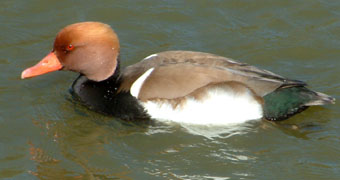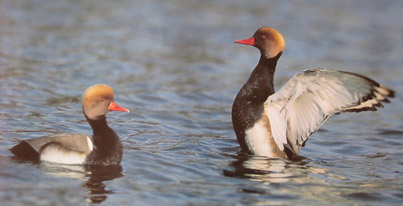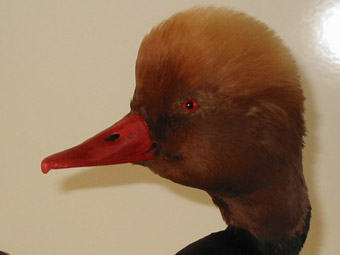Red Crested Pochard.
Common name: Red Crested Pochard 
Scientific name: Netta rufina
Family : Anatidae
Description : It measures53 to 57 cm and weighs 830 g to 1420 g, with a wingspan of 84 to 88 cm. Its beak is quite pointed for a webbed footed bird. The plumage of the male is grey brown on the back and white on the flanks. The head and throat are golden red. Its beak and feet are red. The female is more subtle because she has to go unnoticed during breeding. The underside of the head is a brown, greyish white with the back brown. The underneath is paler. The head seems bigger because of its plumage.
 Reproduction : The female reaches sexual maturity around the age of one and lays between 8 and 10 cream coloured eggs in a nest that she builds herself. Incubation lasts 26 to 28 days. The ducklings remain in the nest. They take their first flight 40 to 50 days after their birth. In
Reproduction : The female reaches sexual maturity around the age of one and lays between 8 and 10 cream coloured eggs in a nest that she builds herself. Incubation lasts 26 to 28 days. The ducklings remain in the nest. They take their first flight 40 to 50 days after their birth. In
Diet: Essentially they eat plants and water seeds, but sometimes they eat small invertebrates that they find in shallow water, they dive 3 to 4 metres (time under water 6 to 10 seconds). 
Habitat: Living especially in warm water areas or at the edge of vegetation. It can be found in
Migration : It can be found in Europe as far as
Conservation : Although numbers have tended to decrease in
Lifespan: It lives up to 7 years.
Cry or song: This duck makes either a resonant “bet” or a “gueng” sound. The female makes a hoarse “karr”.
About the bird: It is a cross between the diving ducks and the surface feeding ducks. It is almost always on the water but it rarely dives. The female sits on the eggs herself and takes the ducklings to water after two months.